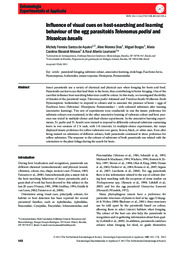Influence of visual cues on host-searching and learning behaviour of the egg parasitoids Telenomus podisi and Trissolcus basalis.
Influence of visual cues on host-searching and learning behaviour of the egg parasitoids Telenomus podisi and Trissolcus basalis.
Autoria: AQUINO, M. F. S. de; DIAS, A. M.; BORGES, M.; MORAES, M. C. B.; LAUMANN, R. A.
Resumo: Insect parasitoids use a variety of chemical and physical cues when foraging for hosts and food. Parasitoids can learn cues that lead themto the hosts, thus contributing to better foraging.One of the cues that in?uence host-searching behaviour could be colour. In this study, we investigated the ability of females of the parasitoid wasps Telenomus podisi Ashmead and Trissolcus basalisWollaston (both Hymenoptera: Scelionidae) to respond to colours and to associate the presence of hosts ? eggs of Euschistus heros (Fabricius) (Hemiptera: Pentatomidae) ? with coloured substrates after training (associative learning). Two sets of experiments were conducted: in one the innate preference for substrate colours was examined, in the other associative learning of substrate colour and host presence was tested in multiple-choice and dual-choice experiments. In the associative learning experiments, Te. podisi and Tr. basalis were trained to respond to differently coloured substrates containing hosts in two sessions of 2 h each, with 1-h intervals. In multiple-choice experiments, the wasps displayed innate preference for yellow substrates over green, brown, black, or white ones. Even after being trained on substrates of different colours, both parasitoids continued to show preference for yellow substrates. The response to the colours of substrates of both parasitoids was related with the orientation to the plant foliage during the search for hosts.
Ano de publicação: 2012
Tipo de publicação: Artigo de periódico
Observações
1 - Por padrão são exibidas publicações dos últimos 20 anos. Para encontrar publicações mais antigas, configure o filtro ano de publicação, colocando o ano a partir do qual você deseja encontrar publicações. O filtro está na coluna da esquerda na busca acima.
2 - Para ler algumas publicações da Embrapa (apenas as que estão em formato ePub), é necessário ter, no celular ou computador, um desses softwares gratuitos. Sistemas Android: Google Play Livros; IOS: iBooks; Windows e Linux: software Calibre.
Acesse outras publicações
Acesse a Base de Dados da Pesquisa Agropecuária (BDPA) para consultar o acervo completo das bibliotecas da Embrapa.

